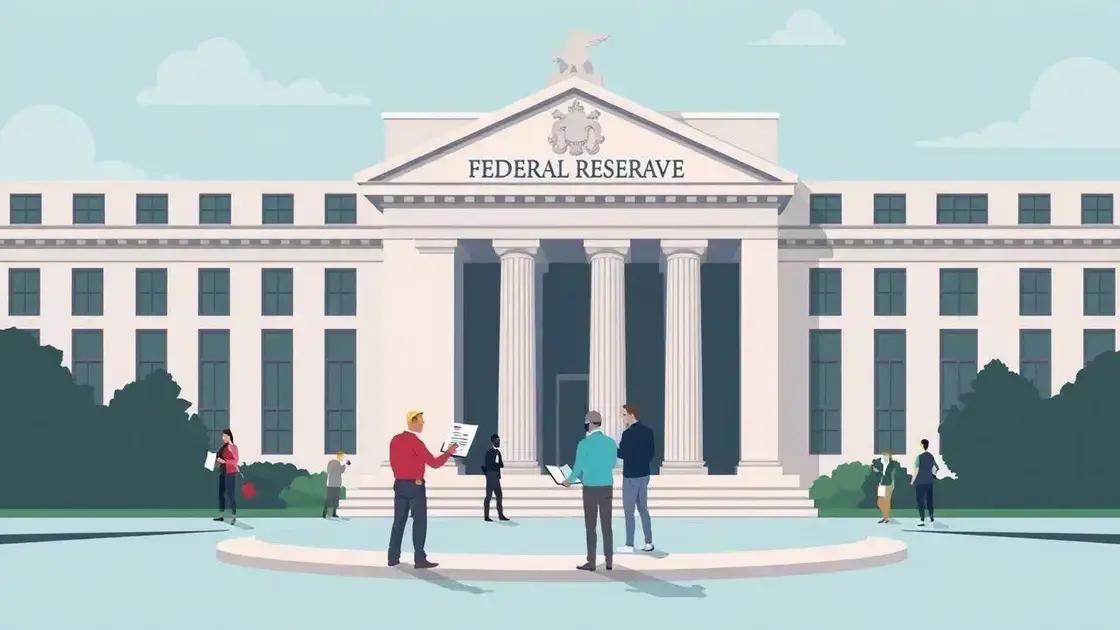Federal Reserve policy impact analysis: What it means for you

Navigating personal finance amid Federal Reserve decisions involves adjusting budgets, managing loans, and reevaluating investments based on interest rate changes to maintain financial stability.
Federal Reserve policy impact analysis sheds light on how central bank decisions shape our economy. Have you ever wondered how these policies influence your finances and investments? Let’s dive in.
Understanding the Federal Reserve’s role
Understanding the Federal Reserve is crucial for grasping how our economy functions. The Federal Reserve, often referred to as the Fed, serves as the central bank of the United States. It controls monetary policy to help stabilize the economy and manage inflation.
The Fed has several key roles that impact our financial system. This includes regulating banks, providing financial services, and conducting monetary policy. All these functions help maintain the health of the economy and ensure a stable financial environment.
The roles of the Federal Reserve
Here are some of the primary roles the Fed plays:
- Monetary Policy: The Fed manages the money supply and interest rates.
- Bank Regulation: It oversees banks to ensure safety and compliance.
- Financial Stability: The Fed monitors risk factors that could affect the economy.
- Payment Services: It provides services to banks and the government.
The implementation of monetary policy is perhaps the most visible role. By adjusting interest rates, the Fed can influence borrowing and spending. For example, lowering rates can encourage more borrowing, which boosts spending and investment. Conversely, increasing rates may help cool down an overheated economy.
Through its various roles, the Federal Reserve plays a significant part in shaping the economic landscape. By making informed decisions, it ensures that the economy remains balanced and resilient. As such, understanding the Federal Reserve’s responsibilities helps individuals comprehend the broader economic environment and its effect on their lives.
The impact of interest rate changes

Understanding the impact of interest rate changes is essential in today’s economic landscape. When the Federal Reserve adjusts interest rates, it influences the entire economy, affecting everything from borrowing costs to consumer spending.
When the Fed lowers interest rates, borrowing becomes cheaper. This encourages individuals to take out loans for homes and cars, as well as promotes businesses to invest in growth. The result is often an increase in consumer spending, which can stimulate economic growth.
Effects of lowering interest rates
Some immediate effects of lower interest rates include:
- Increased borrowing: More people and companies are likely to borrow money.
- Stimulated spending: Lower rates often lead to higher consumer expenditure.
- Boosted investment: Businesses tend to invest in new projects when borrowing costs are low.
- Higher asset values: Lower rates can drive up the market value of homes and stocks.
On the flip side, when the Federal Reserve raises interest rates, the effects can be significant. Borrowing costs increase, which might slow down consumer spending and investment. Higher rates can also lead to a higher cost of living, as loans become pricier.
Consequences of raising interest rates
The primary consequences of increased rates include:
- Reduced borrowing: Higher costs make loans less attractive.
- Decreased consumer spending: People may cut back on purchases as expenses rise.
- Slowed economic growth: Businesses may hesitate to invest due to uncertainties.
- Lower inflation pressure: Higher rates can help control rising prices.
Overall, the impact of interest rate changes is a complex web of effects that ripple through the economy. These adjustments influence how individuals, businesses, and even the government respond to economic conditions. By staying informed on these changes, consumers and investors can make better financial decisions.
How policy shifts affect inflation
Understanding how policy shifts affect inflation is essential for grasping economic trends. When the Federal Reserve changes its policies, it can have a significant impact on the inflation rate, which in turn influences daily life.
One way the Fed influences inflation is through interest rate changes. When the Fed increases rates, borrowing costs rise. This often leads to reduced spending by consumers and businesses. With less money circulating in the economy, the pressure on prices can decrease, keeping inflation in check.
The relationship between interest rates and inflation
Increased interest rates can:
- Reduce consumer spending: Higher loan costs mean people may hold off on buying homes or cars.
- Limit business investment: Companies may delay projects due to higher financing costs.
- Stabilize prices: With less demand, prices are less likely to rise rapidly.
- Encourage saving: Higher interest rates can motivate people to save more than spend.
Conversely, when the Fed lowers interest rates, borrowing becomes less expensive. This can stimulate spending and investment, leading to higher demand for goods and services. Increased demand often puts upward pressure on prices, which can result in higher inflation.
The effects of lower interest rates on inflation
Lower interest rates can:
- Encourage more borrowing: People and businesses are more likely to take out loans.
- Boost consumer confidence: Lower rates can make big purchases more feasible.
- Increase economic activity: More spending can lead to a higher demand for goods and services.
- Raise inflation: With greater demand, prices can start to rise more quickly.
The Federal Reserve’s ability to influence inflation through policy shifts is a powerful tool. Understanding this connection can help individuals navigate their finances and make informed decisions in an ever-changing economic landscape.
Navigating personal finance amid Fed decisions

Navigating personal finance is crucial, especially amid Federal Reserve decisions. The choices made by the Fed can significantly impact individuals’ financial situations. It’s essential to stay informed about these changes to make better financial decisions.
When the Fed alters interest rates or adjusts monetary policy, people may feel the effects in various ways. For example, a rise in interest rates can lead to higher monthly payments on loans and credit cards. This could force individuals to reconsider their budgets and spending habits.
Understanding your budget
Having a clear budget is the foundation of sound financial management. Consider the following tips:
- Track your expenses: Knowing where your money goes helps identify areas to cut back.
- Adjust for interest rate changes: Anticipate potential increases in monthly payments and plan for them.
- Prioritize savings: Aim to save a portion of your income regularly, especially during uncertain times.
- Avoid high-interest debt: Limit the use of credit cards with high rates.
As interest rates rise, it’s also a good time to evaluate your investments. Higher rates typically mean that safer savings options, like savings accounts and bonds, may offer better returns.
Investment strategies during Fed shifts
Consider adopting these investment strategies:
- Diversify your portfolio: Spread your investments across various assets to mitigate risks.
- Focus on fixed-income investments: Explore options like bonds that may benefit from rising interest rates.
- Reassess stock investments: Monitor how changing rates affect stock values and adjust accordingly.
- Consult financial professionals: Seek guidance to ensure your investment strategies align with your goals.
Adapting to the Federal Reserve’s decisions requires active engagement with your finances. By understanding the impacts on personal finance and making informed choices, you can navigate your financial future more effectively. Staying flexible and aware of economic changes will empower you to manage your finances wisely.
In conclusion, navigating personal finance during changes in Federal Reserve policies is essential for making informed decisions. Understanding how interest rate changes can affect your spending, saving, and investing strategies can empower you to manage your finances wisely. By staying aware of these shifts, you can adapt your budget and investment plans accordingly. Remember, proactive financial management can help you thrive even in uncertain economic conditions.
FAQ – Frequently Asked Questions About Navigating Personal Finance Amid Fed Decisions
How do Fed interest rate changes affect my loans?
When the Fed raises interest rates, your loan payments may increase, making borrowing more expensive.
What steps can I take to adjust my budget after a rate change?
Track your expenses carefully and consider reducing discretionary spending to accommodate higher loan payments.
Should I change my investment strategy during Fed policy shifts?
Yes, consider diversifying your investments and focusing on fixed-income options, as they may provide better returns in a rising rate environment.
How can I prepare for inflation due to Fed policies?
Stay informed about economic changes, budget for potential cost increases, and prioritize saving to keep your financial stability.






